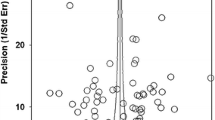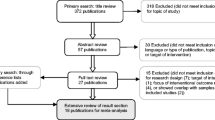Abstract
Background
Several studies have shown that quality of childcare is a potentially important determinant of child outcomes. Despite the enormous growth in public childcare centers in Chile, little is known about the quality of these childcare centers.
Objective
The main purpose was to evaluate the quality of a sample of public childcare centers in Chile and to compare it with the quality levels found in previous Chilean studies. Another goal was to compare the quality in Chilean public childcare centers with that found in other countries worldwide, using the same instrument.
Methods
The study assessed the quality of 17 public childcare centers in Chile using the Infant/Toddler Environment Rating Scale-Revised (Harms et al., Infant/toddler environment rating scale-revised, New York, Teachers College Press, 2006). The results were placed in a Chilean and an international perspective through a meta-analysis involving 2,171 childcare groups in 10 countries
Results
A moderate level of quality of childcare was found, which did not differ from the previous quality levels reported in Chile. Chilean childcare centers scored low on personal care routines (e.g., hygiene) but high on quality of caregiver-child interactions. Chilean quality of childcare is below the worldwide average but comparable to that in various European countries.
Conclusion
It is concluded that the large increase in the number of public childcare centers in Chile during the past 10 years did not negatively affect their quality. Several measures to improve Chilean childcare quality are suggested.



Similar content being viewed by others
References
*Barros, S., & Aguiar, C. (2010). Assessing the quality of Portuguese child care programs for toddlers. Early Childhood Research Quarterly , 25, 527–535.
*Bisceglia, R., Perlman, M., Schaack, D., & Jenkins, J. (2009). Examining the psychometric properties of the Infant-Toddler Environment Rating Scale-Revised Edition in a high-stakes context. Early Childhood Research Quarterly, 24, 121–1.
*Boller, K., Del Grosso, P., Blair, R., Jolly, Y., Fortson, K., Paulsell, D., Lundquist, E., Hallgren, K., & Kovac, M. (2010). The Seeds to Success Modified Field Test: Findings from the Impact and Implementation Studies. Princeton: Mathematic Policy Research, Inc.
Borenstein, M., Hedges, L., Higgins, S., & Rothstein, D. (2009). Introduction to meta-analysis. Chichester: Wiley.
*Burchinal, M. R., Cryer, D., Clifford, R. M., & Howes, C. (2002). Caregiver training and classroom quality in child care centers. Applied Developmental Sciences, 6, 2–11.
Burchinal, M. R., Roberts, J. E., Riggins, R., Zeisel, S., Neebe, E., & Bryant, D. M. (2000). Relating quality of center-based child care to early cognitive and language development longitudinally. Child Development, 71, 339–357.
Bronfenbrenner, U., & Morris, P. A. (1998). The ecology of developmental processes. In W. Damon (Series Ed.) and M. R. Lerner (Vol. Ed.), Handbook of child psychology: Vol. 1. Theoretical models of human development (5th ed., pp. 993–1028). New York: Wiley.
Chile Crece Contigo. (n.d.). Cuatro años creciendo juntos: Memoria de la Instalación del Sistema de Protección Integral a la Primera Infancia: Chile Crece Contigo 2006–2010. [Four years growing together: Memory of implementation of the system of integral protection to early infancy: Chile grows with you 2006–2010]. Retrieved June 11, 2013. http://crececontigo.gob.cl.
Clarke-Stewart, A., & Allhusen, V. D. (2005). What we know about childcare. Cambridge, MA: Harvard University Press.
Cryer, D., Tietze, W., Burchinal, M., Leal, T., & Palacios, J. (1999). Predicting process quality from structural quality in preschool programs: A cross-classroom comparison. Early Childhood Research Quarterly, 14, 339–361.
*Domínguez, P., Moreno, L., Narvaez, L., Herrera, M. O., & Mathiesen, M. E. (2008). Prácticas Pedagógicas de Calidad. Informe Final [Teaching Practices of Quality. Final Report]. Ministerio de Educación de Chile MINEDUC. Retrieved from http://bibliotecacentrodeestudios.mineduc.cl/CEusuarioANONIMO/.
Dussaillant, F. (2012). Asistencia de niños a establecimientos preescolares: aproximación a la demanda a través de un análisis de las elecciones de cuidado y trabajo de los hogares. [Attendance at pre-school children: Approach to the demand through an analysis of the election of care and household work]. Chile: PNUD—Centro de Estudios MINEDUC. Retrieved from http://www.supereduc.cl/usuarios/mineduc/doc/201203261228190.Otra_evidencia.pdf.
*Fenech, M., Sweller, N., & Harrison, L. (2010). Identifying high-quality centre-based childcare using quantitative data-sets: what the numbers do and don’t tell us. International Journal of Early Years Education, 18, 283–296.
*Gevers Deynoot-Schaub, M. J. J. M., & Riksen-Walraven, J. M. A. (2005). Child care under pressure: The quality of Dutch centers in 1995 and 2001. The Journal of Genetic Psychology, 66, 280–296.
*Goelman, H., Forer, B., Kershaw, P., Doherty, G., Lero, D., & LaGrange, A. (2006). Towards a predictive model of quality in Canadian child care centers. Early Childhood Research Quarterly, 21, 280–295.
Harms, T., Clifford, R. M., & Cryer, D. (1980). Early childhood environment rating scale. New York: Teachers College Press.
Harms, T., Clifford, R. M., & Cryer, D. (1998). Early childhood environment rating scale-revised. New York: Teachers College Press.
Harms, T., Cryer, D., & Clifford, R. M. (1990). Infant/toddler environment rating scale. New York: Teachers College Press.
Harms, T., Cryer, D., & Clifford, R. M. (2006). Infant/toddler environment rating scale-revised. New York: Teachers College Press.
Harms, T., Jacobs, E. V., & White, D. R. (1996). School age care environment rating scale, SACERS. New York: Teachers College Press.
*Harrison, L. J. (2010, December). International comparisons of quality using a methodology of objective criteria for centre-based programs for children under five. Paper presented at the Australian Association for Research in Education (AARE) national conference.
*Herrera, M. O., Mathiesen, M. E., Merino, J. M., Recart, I. (2005). Learning contexts for young children in Chile: process quality assessment in preschool centres. International Journal of Early Years Education, 13, 13–27.
*Hestenes, L. L., Cassidy, D. J., Hegde, A. V., & Lower, J. K. (2007). Quality in inclusive and noninclusive infand toddler classrooms. Journal of Research in Childhood Education, 22, 69–84.
*Howes, C., & Smith, E.W. (1995). Relations among child care quality, teacher behavior, children’s play, emotional security, and cognitive activity in child care. Early Childhood Research Quarterly, 10, 381–404.
Junta Nacional de Jardines Infantiles [JUNJI]. (n.d.). Objetivos de Calidad [Quality Goals]. Retrieved June 7, 2013, from http://www.junji.gob.cl/portal/index.php?option=com_k2&view=item&layout=item&id=1443&Itemid=159.
Leslie, L. A., Ettenson, R., & Cumsille, P. (2000). Selecting a child care center: What really matters to parents? Child & Youth Care Forum, 29, 299–322.
Love, J. M., Harrison, L., Sagi-Schwartz, A., Van IJzendoorn, M. H., Ross, C., Ungerer, J. A., et al. (2003). Child care quality matters: How conclusions may vary with context. Child Development, 74, 1021–1033. doi:10.1111/1467-8624.00584.
Ministerio de Educación. (2011). Decreto 53. Ministerio de Educación [Ministry of Education]. MINEDUC: Santiago, Chile Retrieved from http://www.leychile.cl/Navegar?idNorma=1025071&idVersion=2011-05-05.
Ministerio de Educación. (2012a). Decreto 315. Ministerio de Educación [Ministry of Education]. MINEDUC: Santiago, Chile. Retrieved from http://www.leychile.cl/N?i=1026910&f=2012-05-18&p=.
Ministerio de Educación. (2012b). Decreto 548. Ministerio de Educación [Ministry of Education]. MINEDUC: Santiago, Chile. Retrieved from http://www.leychile.cl/Navegar?idNorma=14166&idVersion=2012-07-09.
NICHD Early Child Care Research Network [NICHD ECCRN]. (2002). Child-care structure →process →outcome: Direct and indirect effects of child-care quality on young children’s development. Psychological Science, 13, 199–206.
Noboa-Hidalgo, G. E., & Urzúa, S. S. (2012). The effects of participation in public child care centers: Evidence from Chile. Journal of Human Capital, 6, 1–34.
Organisation for Economic Co-operation and Development. (2012). Education at a Glance: OECD Indicators 2012. Data retrieved June 11, 2013 from http://www.oecd.org/edu/EAG2012%20-%20Key%20Facts%20-%20Chile.pdf.
*Pessanha, M., Aguiar, C., & Bairrão, J. (2007). Influence of structural features on Portuguese toddler child care quality. Early Childhood Research Quarterly, 22, 204–214.
Peisner-Feinberg, E. S., & Burchinal, M. R. (1997). Relations between preschool children’s child-care experiences and concurrent development: The Cost, Quality, and Outcome Study. Merrill-Palmer Quarterly, 43, 451–477.
*Petrogannis, K. (2002). Greek day care centres’ quality, caregivers’ behaviour and children’s development. International Journal of Early Years Education, 10, 138–148.
*Rentzou, K. (2010). Using the ACEI global guidelines assessment to evaluate the quality of early child care in Greek settings. Early Childhood Education Journal, 38, 75–80.
*Rocha, A. B., & Bhering, E. (2006). Um estudo sobre creches como ambiente de desenvolvimento. [A study on day-care centers as development context]. Cadernos de Pesquisa, 36, 573–596.
Rose, K. K., Vittrup, B., & Leveridge, T. (2013). Parental decision making about technology and quality in child care programs. Child & Youth Care Forum, 42, 475–488. doi:10.1007/s10566-013-9214-1.
*Scarr, S., Eisenberg, M., & Deater-Deckard, K. (1994). Measurement of quality in child care centers. Early Childhood Research Quarterly, 9, 131–151.
Seguel, X., Edwards, M., Hurtado, M., Bañados, J., Covarrubias, M., Wormald, A., et al. (2012). ¿Qué efecto tiene asistir a sala cuna y jardín infantil desde los tres meses hasta los cuatro años de edad? Estudio longitudinal en la Junta Nacional de Jardines Infantiles [What is the effect of attending nursery school between three months and four years of age? A longitudinal study in the National Preschool Association]. Psykhe, 21, 87–104.
*Tietze, W., & Cryer, D. (2004). Comparisons of observed process quality in German and American infant/toddler programs. International Journal of Early Years Education, 12, 43–62.
*Torquati, J. C., Raikes, H. H., Huddleston-Casas, C. A., Bovaird, J. A., & Harris, B. A. (2011). Family income, parent education, and perceived constraints as predictors of observed program quality and parent rated program quality. Early Childhood Research Quarterly, 26, 453–464.
United Nations Educational, Scientific and Cultural Organization. (2012). EFA global monitoring report, 2012: Expanding equitable early childhood care and education is an urgent need. Paris: UNESCO. Retrieved from UNESCO website: http://unesdoc.unesco.org/images/0021/002160/216038E.pdf.
Vandell, D. B. (2004). Early child care: The known and the unknown. Merrill-Palmer Quarterly, 50, 387–414.
Vandell, D., Belsky, J., Burchinal, M., Steinberg, L., Vandergrift, N., & the NICHD Early Child Care Research Network. (2010). Do effects of early child care extend to age 15 years? Results from the NICHD Study of Early Child Care and Youth Development. Child Development, 81, 737–756. doi:10.1111/j.1467-8624.2010.01431.x.
*Varin, D., Crugnola, C. R., Molina, P., & Ripamonti, C. (1996). Sensitive periods in the development of attachment and the age of entry into day care. European Journal of Psychology of Education, 11, 215–229.
*Vermeer, H. J., Van IJzendoorn, M. H., De Kruif, R. E. L., Fukkink, R. G., Tavecchio, L. W. C., Riksen-Walraven, J. M. A., & Van Zeijl, J. (2008). Child care in the Netherlands: Trends in quality over the years 1995–2005. The Journal of Genetic Psychology, 169, 360–385.
Villalón, M., Suzuki, E., Herrera, M., & Mathiesen, M. (2002). Quality of Chilean early child-hood education from an international perspective. International Journal of Early Years Education, 10, 49–59. doi:10.1080/09669760220114845.
Whitebook, M., Howes, C., & Philips, D. (1990). Who cares? Child care teachers and the quality of care in America: Final report, National child care staffing study. Oakland, CA: Child Care Employee Project.
Acknowledgments
This study was made possible by a grant awarded to the first author by the National Commission for Scientific and Technological Research CONICYT, Chile (Becas Chile). We would like to thank the Junta Nacional de Jardines Infantiles JUNJI Araucanía in Chile and the Corporación Municipal de Castro for their invaluable collaboration.
Author information
Authors and Affiliations
Corresponding author
Rights and permissions
About this article
Cite this article
Cárcamo, R.A., Vermeer, H.J., De la Harpe, C. et al. The Quality of Childcare in Chile: Its Stability and International Ranking. Child Youth Care Forum 43, 747–761 (2014). https://doi.org/10.1007/s10566-014-9264-z
Published:
Issue Date:
DOI: https://doi.org/10.1007/s10566-014-9264-z




